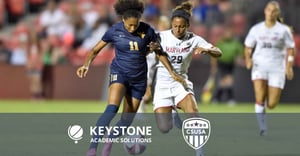- SERVICES
- HIGHER EDUCATION MARKETING
- ENGAGEMENT & ENROLLMENT MANAGEMENT
- STUDENT RECRUITMENT AGENCIES
- PROFESSIONAL EDUCATION & TRAINING
- WHO WE ARE
WHO WE ARE
Learn more about Keystone Education Group, including our leadership structure, why choose Keystone as your educational partner, and company press releases.
QUICK LINKS
- RESOURCES
RESOURCES
Find a range of helpful resources to help with your educational marketing. From on-demand webinars, reports & data, to customer testimonials and our downloadable media kit.
QUICK LINKS
- NEWS
- REQUEST A CALL

- Keystone Higher Education News
- Sports Recruitment in Higher Education
For those with an aptitude for athletics, sports might provide a unique pathway to higher education. In the United States, sports recruitment offers many students the opportunity to play their chosen sport while earning a degree. According to ncaa.org, over eight million students currently participate in college athletics. Additionally, “More than eight out of 10 student-athletes will earn a bachelor’s degree, and more than 35 percent will earn a postgraduate degree.”
To help these students, there are many services available such as CSUSA, which are designed to help students find the right college and team, guiding them and helping them to connect with potential universities. For those who want to learn more about playing sports in college, we’ve gathered some information.
The process of getting recruited:
For many high school students, college athletics is the way towards achieving their higher education. Understanding how the recruitment process works can help students get better prepared. As ivywise.com reports, “recruitment is a two-way street,” between the student and their future team. Students should spend time researching programs in order to make sure they’re a good fit, both academically and athletically.
The recruitment process generally starts with the student-athlete receiving a letter of interest from a coach or program. This doesn’t mean the student is being actively recruited but is an opportunity for universities to build awareness about their sports programs. Students interested in playing college sports should start by having a conversation with their current coach to determine if it’s feasible for them to play at a higher level. After that, students should begin researching colleges and programs of interest. Once the student has a list of places they’re interested in, they should start reaching out to coaches. Send an updated resume, sports stats, and game footage, if possible. Students may also want to familiarize themselves with the NCAA timelines and rules for recruitment.
Students who are being recruited will either receive a phone call, a visitor will receive a formal invitation to join the team. In the meantime, students should make sure they’re being appropriate on their social media, as they want to be the best representation of themselves for their future schools and team. Additionally, students should continue to focus on maintaining a good GPA. Even if a coach wants to recruit a student, they can’t guarantee admittance to the university without good grades.
Scholarships:
While considering options, students and their parents should also be aware not all schools offer scholarships. For example, Division III schools offer no sports scholarships to student-athletes, whereas other divisions may offer partial or full scholarships. It’s ultimately dependent upon the school and sports program.
Division I schools, of which there are 350 schools in the United States that qualify, generally have the most money to give to students. Students that play at this level are not only held to the highest standards athletically but also academically.
For those attending a Division II school, there’s generally less compensation offered to student-athletes. With that being said, students at these schools are expected to maintain high GPAs but are often afforded more time to get involved on campus. There are about 300 schools that compete at the Division II level.
In Division III, which has 450 schools with over 18,000 student-athletes, students enjoy shorter sports seasons. This gives more time to focus on academics, as well as gain further connections to their campus. Students who play Division III sports generally aren’t offered sports scholarships but may be awarded merit-based scholarships for good grades.
International students:
While the road to earning a sports scholarship might be a bit tougher for international students, it can certainly be done. According to usnews.com, there are three things a prospective international student-athlete should do before trying to earn a spot on a US university sports team. This includes starting early, understanding the college sports organizations and their functions, then working on developing their online presence.
Students who want to attend university in the United States and play sports should start looking into their options 18-24 months before they’d like to start school. In addition, students will need to have excellent grades, and will probably need to take an English language proficiency test.
International students, much like students from the United States, should also spend time researching the three college sports organizations to better understand their options. As not all organizations or schools provide scholarships, it’s important for students to know exactly what’s offered by each. This should be extended to the universities they hope to attend as well. Students should spend time researching to make sure they understand exactly what’s required of them to apply before reaching out.
With COVID-19 grinding the world to a halt, many coaches haven’t been able to travel to recruit. Therefore, it’s up to students, especially international students, to capture a coach’s attention by creating a strong online presence. Students can use social media to highlight their high school sports career, connect with coaches, or post-game footage so recruiters can view it. Kyle Winters, recruiting manager for Next College Student Athlete (NCSA) said “...if an international student-athlete does everything they can to be seen online – actively connect with college coaches and keep their grades up – they'll have a much better chance of earning a scholarship."
While pursuing a placement on a college team can feel overwhelming, it doesn’t have to be something that stops students from participating in the recruitment process. For international students understanding the system, being prepared, and staying a few steps ahead can make all the difference. For students in the United States hoping to play at the collegiate level, many of the same applications. Take the time to research the school you hope to attend, get serious about honing your skills and make sure your expectations match what your prospective school has to offer.
More about:
Related Tags
Just For You
Top Picks
Higher Ed Chats Podcast
Listen to the latest episodes of our Higher Ed Chats Podcast - new format for 2024. Hear from Higher Ed thought-leaders from around the world!
Who Will Win The Keystone Awards?

Watch the Keystone Awards Ceremony to see the winners of the 2025 Keystone Awards!
Subscribe
to get the latest news and updates





